
Star Control: Famous Battles of the Ur-Quan Conflict, Volume IV is an action-strategy video game developed by Toys for Bob and published by Accolade. It was originally released for MS-DOS and Amiga in 1990, followed by ports for the Sega Genesis and additional platforms in 1991. The story is set during an interstellar war between two space alien factions, with humanity joining the Alliance of Free Stars to defeat the invading Ur-Quan Hierarchy. Players can choose to play as either faction, each with seven different alien starships which are used during the game's combat and strategy sections.
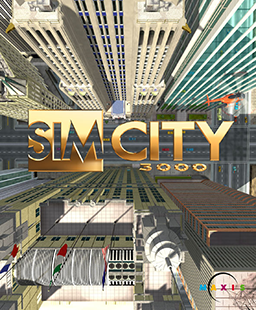
SimCity 3000 is a city building simulation video game released in 1999, and the third major installment in the SimCity series. It was published by Electronic Arts (EA) and developed by series creator Maxis. It was released for Microsoft Windows, Macintosh, and, through an arrangement with Loki Games, Linux.
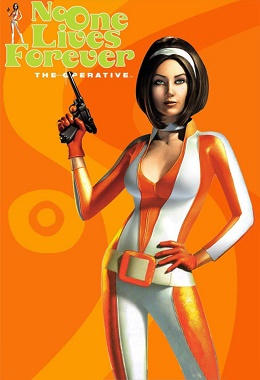
The Operative: No One Lives Forever is a first-person shooter video game developed by Monolith Productions and published by Fox Interactive, released for Windows in 2000. The game was ported later to the PlayStation 2 and Mac OS X in 2002.
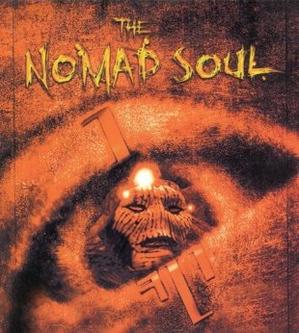
The Nomad Soul is an adventure game developed by Quantic Dream and published by Eidos Interactive. It was released for Microsoft Windows in 1999 and Dreamcast in 2000. The player can engage in unarmed and armed combat, explore the three-dimensional environment of Omikron City, and talk with non-player characters to progress the story. It follows an investigation into a case of serial killings, which unravels the supernatural truth behind the city's ancient history.

Baldur's Gate II: Shadows of Amn is a role-playing video game developed by BioWare and published by Interplay Entertainment. It is the sequel to 1998's Baldur's Gate and was released for Windows in September 2000. Following its predecessor, the game takes place in the Forgotten Realms, a fantasy campaign setting, and is based on the Advanced Dungeons & Dragons 2nd edition rules. Powered by BioWare's Infinity Engine, Baldur's Gate II uses an isometric perspective and pausable real-time gameplay. The player controls a party of up to six characters, one of whom is the player-created protagonist; the others are certain characters recruited from the game world.

Aliens Versus Predator is a 1999 science fiction first-person shooter video game developed by Rebellion Developments and published by Fox Interactive for Microsoft Windows, Mac OS, and Mac OS X. It is a part of the Alien and Predator crossover franchise, Alien vs. Predator. A sequel, Aliens Versus Predator 2, was developed by Monolith Productions and released by Sierra in 2001.

F.E.A.R. First Encounter Assault Recon is a 2005 first-person shooter psychological horror video game for Windows, PlayStation 3, and Xbox 360. Developed by Monolith Productions and published by Vivendi Universal Games, the Windows version was released worldwide in October 2005. The Xbox and PlayStation versions were ported by Day 1 Studios and released in October 2006 and April 2007, respectively. Two standalone expansion packs were released for the Windows and Xbox 360 versions of the game, both developed by TimeGate Studios; F.E.A.R. Extraction Point (2006) and F.E.A.R. Perseus Mandate (2007). Released on Windows in March 2007, F.E.A.R. Gold Edition includes all the content from the Director's Edition plus Extraction Point, while F.E.A.R. Platinum Collection, released for Windows in November 2007, includes the Director's Edition, Extraction Point, and Perseus Mandate. Neither expansion is now considered canon, as the Monolith-developed F.E.A.R. 2: Project Origin ignores the events of both.

Caesar III is a city-building game released on September 30, 1998, for Microsoft Windows and Mac OS, developed by Impressions Games and published by Sierra On-Line. It is the third installment of the Caesar series of games and is part of Sierra's City Building series. Players assume the role of a provincial governor to build thriving cities across the Roman Empire, in which they must ensure their citizens have their needs met, and deal with various disasters, angry gods and hostile enemies. The developers of Caesar III designed the game in response to critiques of its predecessor, introducing branching missions, a merged map for city-building and combat, and a "walker" mechanic for citizens of the city to affect their surroundings. Caesar III was released to positive critical reception, with praise directed at the game's visual presentation and complex design, and criticism levelled at its military features.
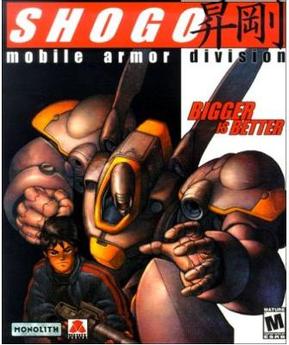
Shogo: Mobile Armor Division is a first-person shooter video game developed by Monolith Productions and published by Monolith and Interplay Entertainment in 1998. The game features on-foot first-person shooter action, and combat with anime-style bipedal mechs. Shogo is a combat system that features the possibility of critical hits, whereby attacking an enemy will occasionally bring about a health bonus for the player. Players take on the role of Sanjuro Makabe, a Mobile Combat Armor (MCA) pilot and a commander in the United Corporate Authority (UCA) army, during a brutal war for the planet Cronus and its precious liquid reactant, kato. Players must locate and assassinate a rebel leader known only as Gabriel. At two pivotal points in the game, the player also has the opportunity to make a crucial decision, which can alter the game's ending.

Jagged Alliance 2 is a tactical role-playing game released in 1999 for Microsoft Windows and later ported to Linux by Tribsoft. It is the third entry in the Jagged Alliance series. The game was followed by the expansion Unfinished Business in 2000. Two commercial versions of the mod Wildfire were released in 2004 in the form of expansion packs. The core game and the Unfinished Business expansion were combined and released under the title Jagged Alliance 2 Gold Pack in 2002.
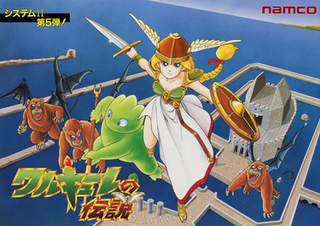
Valkyrie no Densetsu is a 1989 action-adventure role-playing arcade game developed and published in Japan by Namco. It is a follow-up to the Family Computer game Valkyrie no Bōken (1986). Players control the warrior maiden Valkyrie and her lizard-like companion Kurino Xandra as they set out to drop a mythical item called the Golden Seed into the Northern Fountain to replenish the dying crop fields of Xandra Land. Gameplay involves defeating enemies and collecting gold to purchase magical spells and weapons in shops.

F.E.A.R. Extraction Point is the first expansion pack for the first-person shooter psychological horror video game F.E.A.R. First Encounter Assault Recon. Developed by TimeGate Studios and originally published by Vivendi Games under the Sierra Entertainment label, it was released for Windows in October 2006 and for Xbox 360 in November 2007. The Xbox version was only available packaged with another expansion, F.E.A.R. Perseus Mandate, and released as F.E.A.R. Files. On the PC, as well as a standalone release, Extraction Point was also bundled with the original game for F.E.A.R. Gold Edition, released in March 2007, and with the original game and Perseus Mandate for F.E.A.R. Platinum Collection, released in November 2007. The Platinum Collection was also released on Steam in 2012 and GOG.com in 2015. In 2021, F.E.A.R. Files was added to Microsoft's backward compatibility program, making the games playable on the Xbox One and Xbox Series X/S. Neither expansion is now considered canon, as the Monolith Productions-developed F.E.A.R. 2: Project Origin ignores the events of both.
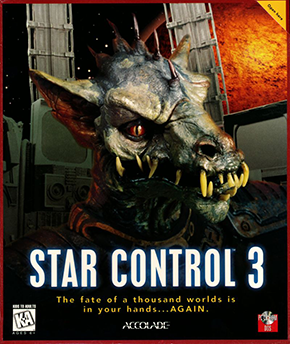
Star Control 3 is a 1996 action-adventure game developed by Legend Entertainment and published by Accolade. The third installment in the Star Control trilogy, the game was released for MS-DOS in 1996 and Mac OS in 1998. The story takes place after Star Control II, beginning with a disaster that disrupts superluminal travel through hyperspace. This leads the player to investigate a new quadrant of space, joined by allied aliens from the previous games.

F.E.A.R. Perseus Mandate is the second standalone expansion pack for the first-person shooter psychological horror video game F.E.A.R. First Encounter Assault Recon. Developed by TimeGate Studios and originally published by Vivendi Games under the Sierra Entertainment label, it was released for Windows and Xbox 360 in November 2007. The Xbox version was only available packaged with the first expansion, F.E.A.R. Extraction Point, and released as F.E.A.R. Files. On the PC, as well as a standalone release, Perseus Mandate was also bundled with the original game and Extraction Point for F.E.A.R. Platinum Collection, which was also released on Steam in 2012 and GOG.com in 2015. In 2021, F.E.A.R. Files was added to Microsoft's backward compatibility program, making the games playable on the Xbox One and Xbox Series X/S. Neither expansion is now considered canon, as the Monolith Productions-developed F.E.A.R. 2: Project Origin ignores the events of both.
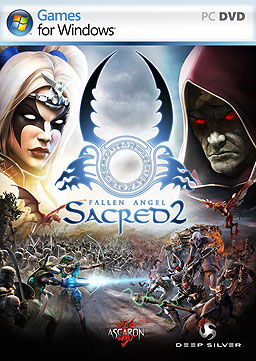
Sacred 2: Fallen Angel is a 2008 action role-playing game and the second in the Sacred video game series. It is a prequel which takes place 2,000 years before the events of Sacred. Like its predecessor, the game takes place in a fantasy setting. A new game engine allows the game to be rendered in perspective correct 3D, while retaining the viewpoint found in older isometric games. Game designer Bob Bates was involved in its production. Power metal band Blind Guardian wrote the song "Sacred Worlds" as the theme for the game and also make an appearance as characters.
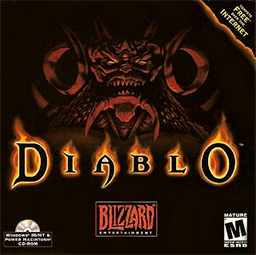
Diablo is an action role-playing video game developed by Blizzard North and released by Blizzard Entertainment in January 1997, and is the first installment in the video game series of the same name.

Star Trek: Voyager – Elite Force is a first-person shooter video game developed by Raven Software and published by Activision. The game was originally released on September 15, 2000 for Windows and Mac OS. A port for Mac OS developed by Westlake Interactive and published by Aspyr Media was released on November 20, 2002. Elite Force was ported to the PlayStation 2 by Pipe Dream Interactive and published by Majesco Entertainment on December 11, 2001.

Terraria is a 2011 action-adventure sandbox game developed by Re-Logic. The game was first released for Windows and has since been ported to other PC and console platforms. The game features exploration, crafting, building, painting, and combat with a variety of creatures in a procedurally generated 2D world. Terraria is one of the best-selling video games of all time, selling 58.7 million copies as of 2024.
F.E.A.R. is a first-person shooter psychological horror video game series created by Craig Hubbard in 2005. Released on Windows, PlayStation 3, and Xbox 360, there are three main games in the series; F.E.A.R. (2005), F.E.A.R. 2: Project Origin (2009), and F.E.A.R. 3 (2011). There are also two standalone expansion packs for the first game; F.E.A.R. Extraction Point (2006) and F.E.A.R. Perseus Mandate (2007), but these games are no longer considered canon, as their plots were ignored in Project Origin and F.E.A.R. 3. In 2014, F.E.A.R. Online, a free-to-play game, was released, but the servers were shut down in 2015 with the game still in open beta. Monolith Productions developed the original game and Project Origin; Day 1 Studios developed F.E.A.R. 3; TimeGate Studios developed Extraction Point and Perseus Mandate; Inplay Interactive developed F.E.A.R. Online. Initially, the series' publishing rights were owned by Vivendi Games, who published the original game and the two expansions under the Sierra Entertainment label. In 2008, Warner Bros. Interactive Entertainment acquired the publishing rights and went on to publish Project Origin and F.E.A.R. 3. Aeria Games published F.E.A.R. Online under license from Warner.

Middle-earth: Shadow of Mordor is a 2014 action-adventure game developed by Monolith Productions and published by Warner Bros. Interactive Entertainment. An original story based on the legendarium created by J. R. R. Tolkien, the game takes place between the events of The Hobbit and The Lord of the Rings film trilogies. The player controls Talion, a Gondorian Ranger who bonds with the wraith of the Elf Lord Celebrimbor, as the two set out to avenge the deaths of their loved ones. Players can engage in melee combat, and use wraith abilities to fight and manipulate enemies. The game introduces the Nemesis System, which allows the artificial intelligence of non-playable characters to remember their prior interactions with Talion and react accordingly in subsequent encounters.




















